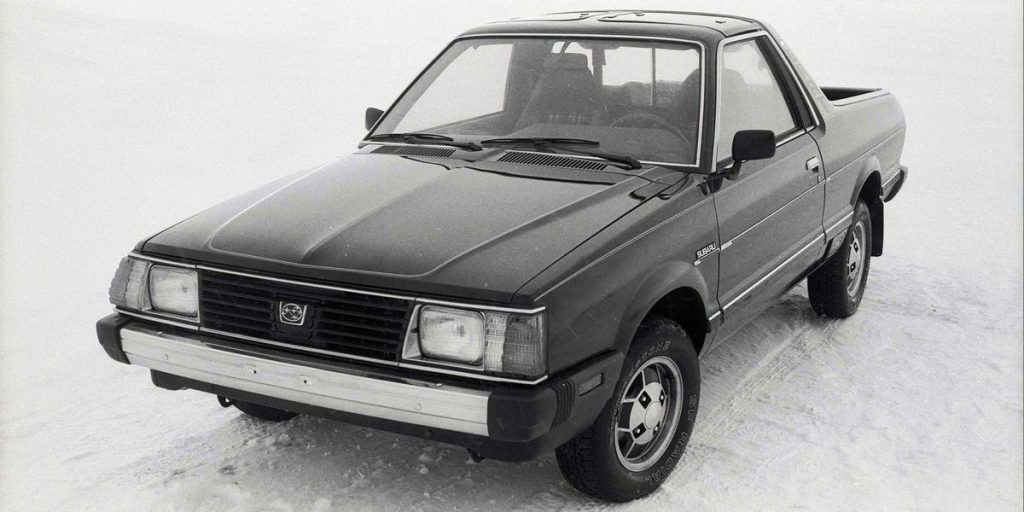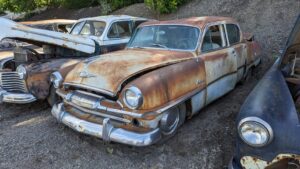Tested: 1982 Subaru BRAT GL

From the July 1982 issue of Car and Driver.
That beat of the different drummer that sets cadence for the wacky side of life—could it be that Subaru wrote the original score? A look at its corporate record is bound to convince you so. Over the past quarter-century, six Japanese firms have eagerly migrated to America to expand their export horizons, while one company—Subaru—had to be cajoled here (some say exhibiting the Japanese equivalent of kicking and screaming) by the persuasive powers of Malcolm Bricklin. The aforementioned six each established a beachhead on the West Coast, while Subaru opted for: a corporate headquarters across the continent in Pennsauken, New Jersey. The left-bank clique is still just a series of remote outposts for the Japanese parent firms, while Subaru has become an American-managed enterprise with stock offered to the public in over-the-counter trading.
Subaru goes about the business of selling cars just as distinctively. When Datsun, Toyota, et al., zeroed in on the population centers of this vast land to build splashy dealerships, Subaru took a lower-profile rural route. In the late Sixties it wasn’t at all unusual to find a Subaru sign swinging in the breeze in front of the odd country gas station or implement dealer.
Subarus were weird beasts back then, with pinched styling, cramped interiors, clattering engines, and front-wheel drive. Of course, this was front-wheel drive before any of the Japanese (including Honda) acknowledged that such a layout was the only right way to build a small car. As a result, Subarus were just a bit too avant-garde to cut it in suburbia. Instead they prowled America’s back yard, building a reputation for bad-weather prowess at ski resorts, on mountain trails, and in farm country. By 1976 four-wheel drive had started filtering into Subaru’s cars—well in advance of AMC’s similar move—and practically overnight they became the best-selling import line in four states (Maine, Idaho, West Virginia, and Alaska).
Past Pickups and a Visual History of Subaru in the U.S.
As different as the Subaru strategy may sound, it still doesn’t fully explain the BRAT. Is it a car or is it a truck? Will it do a hard day’s work, or is the box in back just a playpen for the kids? And those vestigial gull wings in the roof—could they possibly be Bricklin’s final revenge? Set your dial for full weird, folks; we’re off to the far end of the strange-but-true Subaru spectrum.
Strange but more than a little wonderful, as it turns out. The old love-to-hate-it BRAT is gone, replaced this year with a new and improved version that’s trying its damnedest to be a model four-wheel-driver. Check the facts: its mini Ranchero styling fits the handyperson’s dream; the interior is roomy enough for two six-footers, yet the compact exterior doesn’t hog too much garage space; it drives like a real car on dry pavement but is practically unstoppable off-road; and it will haul a full ton without overtaxing the tires or chassis. All for less than $9000 and more than twenty miles per gallon. Who in the market for a dirt digger could ask for more?
You may have noticed here that we’ve neatly skirted the burning question, “What exactly is a BRAT?” The answer to that depends on whom you ask. Subaru says that the name stands for BiDrive Recreational All-Terrain Transporter. This, of course, is a smokescreen. The EPA (for emissions-control purposes) considers it a light-duty vehicle (as opposed to a light-duty truck). The DOE (for fuel-economy purposes) calls the BRAT a special-purpose vehicle. U.S. Customs (for tariff purposes) has ruled it’s not a truck, because the cargo bed is too small and it’s littered with plastic seat and carpeting, of all things. The National Highway Traffic Safety Administration calls it a multipurpose passenger vehicle. Clearly, our federal government is confused by the BRAT, which is probably what Subaru had in mind all along. We, however, know exactly what it is: the BRAT is a truckette. It seats two in comfort, will haul a payload (including passengers) of 2220 to 2245 pounds (depending on the model), and does just fine with bulky items if you’re prepared to amputate the drive-in-movie deck chairs.
What makes the BRAT so good this time around is that the front half is essentially a Subaru sedan. This bodywork came to light in 1980 (supposedly after seven years of preparation), generating rave reviews from Subaru fans around the globe. Last year, Subaru doled the (old) BRAT a larger engine and a dual-range transfer case. For 1982, it all comes together. The bolstered powertrain, the shapely sedan’s front half, and a new cargo bed have all been welded together to make super BRAT.
At the core of it all lies a powertrain amazingly Quattro-like: first an engine, then a drive for the front wheels, then a transmission, and lastly a conventional final-drive for the rear wheels. The engine is a 71-horsepower thumper. In layout, it’s a flat four—in other words, a water-cooled Beetle motor. The transaxle offers four forward gears, plus reverse, plus a three-mode selector lever: you can have conventional front-wheel drive or four-wheel drive in your choice of low or high range. One click up on the central L-handled lever engages 4wd high; two clicks put you into granny gear, which multiplies all five transmission ratios by a 1.462 torque-multiplication factor.
The result is a delightful combination of low gearing for off-road torque and high gearing for efficient highway cruising. The BRAT is not, however, a full-time four-wheel-driver like the AMC Eagle and the Audi Quattro. Since its transaxle contains no center differential, the four-wheel-drive mode is not a good idea for dry pavement (high-traction cornering will cause “windup” stresses in the powertrain). This really isn’t a big handicap, however, because the selector system is synchronized so you can change modes quite handily on the fly. Furthermore, having no open center differential means that no matter what traction conditions you encounter, power flows to at least one front and one rear wheel.
Our test BRAT worked surprisingly well on the highways and byways of Michigan last winter. It climbed a 32 percent snow-covered grade with ease (in 4wd). It was an absolute demon in a snow-clogged forest. It was most cordial (for a truck) on the day-to-day dry-road work commute.
One thing did stop our BRAT in its tracks, however: a combination of excess bravado and insufficient foresight. We set sail across a frozen lake in 4wd, only to bog down in one section of soft, deep snow. This, of course, is the trap that all who venture off road must fall victim to at least once, but we did it without taking advantage of Subaru’s one new claim-to-fame feature: adjustable ground clearance. Normally, the BRAT’s lowest mechanicals clear the pavement by 8.9 inches; this very respectable dimension is due to the fact that the independent suspension at both ends permits the differentials to be mounted well up into the chassis. (A sump guard for the engine is standard equipment.) More amazing is that an extra inch of ground clearance is available at the turn of a wrench. In front, a pair of bolts under each spring seat will raise this truckette by its bootstraps, while in back it’s a matter of adjusting one anchor screw that positions the fixed center portion of the transverse torsion bar. Had we turned screws at the right time, chances are the BRAT would have blasted through the winter with a perfect, never-stuck record.
While the BRAT acts sufficiently trucky when it needs to, its long list of thoughtful gadgets and goodies makes it almost carlike. There are sliding glass panels at the back of the cab. A “kickstep,” hidden behind a spring-loaded door just ahead of the left rear tire, amounts to a modern-day stirrup for mounting the two hind saddles. At the front is an extra cyclopian headlamp provided for off-road use, so effectively hidden behind a hinged escutcheon that you’ll need a sales brochure to find it. Subaru’s unique Hill-Holder is a cooperative effort between the clutch linkage and the brake system to keep you from rolling backwards after you’ve stopped on a hill. The instrument panel is a full-service field of six very effective orange-on-black instruments, plus a somewhat less useful graphic display that tattletales on doors ajar, unfastened seatbelts, and the like. With GL trim ($750 above and beyond the $6863 base BRAT DL), you get a tiltable steering column, an adjustable-lumbar-support driver’s seat, and handy pockets sprinkled hither and yon.
The BRAT’s new skylights are an especially neat trick. The roof at first appears to be a T-top, but the lateral edges of the ceiling are intact. Two transparent panels flip up for ventilation, and can be removed altogether if the mood strikes. (The rear wall of the passenger cabin has a pair of stowage straps to prevent damaging the panels while you’re running- alfresco.) If the “Halo Twin Roof” happens not to be your cup of tea, you can buy a conventional ceiling in the base DL. Unfortunately, all BRATs come with mud flaps, a screaming targa stripe, and oversized 4wd branding-iron scars.
We experienced no water or wind leakage with the gull-wing roof, no doubt partly because this is really just a pair of aerial holes and not a true T-top. The door glass, however, is a different matter. Subaru has gone for the hardtop look in its quest to build a true miniRanchero, so the side windows are frameless. Wind noise starts at 55 mph and intensifies with velocity.
Then there’s the box. The plastic chairs strike us as silly, particularly with their ejector-seat grab handles and adjustable headrests. Unfortunately, these eye sores are welded in place. Fortunately, the use of a hot wrench (oxy-acetylene torch) or a hacksaw will cure the problem in a jiffy. The wall-to-wall Ozite is even easier to remove. Once you clear the deck, there’s a 63-by-52-by-17-inch cargo bay rated at roughly a ton, depending on the number of passsengers onboard.
Even though the BRAT is a highly versatile device, it makes no attempt to do everything. The simple act of hauling even a medium-sized family, for example, is out of the question. But what the BRAT does, it does well. And more important, Subaru’s truckette always seems happy in its work.
It’s a pity you can’t say that about more cars on the road. Let’s face it, the American car/truck market is jammed with model after model that look and act alike. Who knows why they’re here or where they’re going? Subaru BRATs, on the other hand, demand no existential cogitation whatsoever. Their mission in life is clear-cut and distinctive—just the way it should be.
Counterpoint
Steal another look at this BRAT. Cute, fun, a little nutty, but not exactly full of promise for the sporty driving experience, right? We’re not talking about the off-road experience here (which is an absolute blast), no indeed, we’re talking about all the socially acceptable stuff you can go whizzing over in this little devil: the winding roads, the endless Interstates, the favorite run down along the river and through the trees.
Nope, taken at the value of its face, the BRAT just shouldn’t amount to much when faced with the potential pleasures of everyday driving. After all, it’s a shrunk-down four-wheel-drive pickup (or front-wheel-drive if that’s all you need at the moment). And ask P.J. O’Rourke, when was the last time a pickup drove like a good car? Try the Twelfth of Never. Until Subaru came along and did the job right. The BRAT’s steering is great, its suspension is a thing of joy, and its road manners are unassailably masterful. Almost every subjective message is just deeelightful. Except for the ones from its raspy little engine, which perpetually feels as if it’s got a piece of strip sirloin wedged in its little throat. I keep wanting to do the Heimlich maneuver on it. —Larry Griffin
If you want to show me a good time, show me a good four-wheel-drive truck and a two-track through the woods. Show me a Subaru BRAT. and I’ll get the map.
You might find it difficult to justify owning a vehicle as frivolous as a BRAT. Mostly, it’s just a good time, and there’s a lot more to life than that, as our managing editor is wont to remind me.
I can at least see the value of the BRAT’s jump seats, having spent more than one weekend bouncing on more than one case of empty beer cans in the back of more than one pickup. Stores don’t refund your deposit if the cans are smashed flat. There’s seven bucks an outing saved already.
So it only holds two people in the winter; there’s only me and the old man anyway. The dogs don’t care if the jump seats are filled with snow. And speaking of snow, the BRAT’s front-wheel drive pulls through it so well that most of the time you don’t need the rear differential. That means you’re usually getting the most of its 27-mpg-city rating.
And there’s tons to be said about the psychological benefits of a good time… —Jean Lindamood
I’ll admit my bias up front: I don’t have much use for four-wheel-drive trucks. If I want abuse, I can find some less expensive and more interesting ways of getting it. Most small four-wheel-drive trucks pound you. They drone. They usually fall all over themselves if you try to drive them like cars.
Then there’s the BRAT. I must admit, it has me charmed. It strikes just the right compromise between econobox and trucklet. It doesn’t kill your kidneys. It doesn’t try to go belly-up when you change lanes. Yet its body and agricultural-sounding engine feel bulletproof. It’s civilized, yet not so civilized that you feel bad for treating it rough.
As if that weren’t enough, it’s chockfull of useful gear, and it fairly sips gas. Against all this goodness, my defenses crumble. If the BRAT can earn the affection of an avowed truck-hater like me, it should have the weekend brush-basher crowd doing backflips. —Rich Ceppos
Specifications
Specifications
1982 Subaru BRAT GL
Vehicle Type: front-engine, front/four-wheel-drive, 2-passenger, 2-door pickup
PRICE
Base/As Tested: $7613/$8787
Options: air-conditioning, $649; AM/FM-stereo radio/cassette, $494; carpeted floor mats, $31
ENGINE
DOHC 16-valve flat-4, aluminum block and heads
Displacement: 109 in3, 1782 cm3
Power: 71 hp @ 4400 rpm
Torque: 94 lb-ft @ 2400 rpm
TRANSMISSION
4-speed automatic
CHASSIS
Suspension, F/R: strut/live axle
Brakes, F/R: 7.2-in disc/7.1-in drum
Tires: Bridgestone SF Radial
P185/70SR-13
DIMENSIONS
Wheelbase: 96.3 in
Length: 169.3 in
Width: 64.4 in
Height: 56.9 in
Passenger Volume: 45 ft3
Curb Weight: 2320 lb
C/D TEST RESULTS
60 mph: 14.3 sec
80 mph: 37.1 sec
1/4-Mile: 19.4 sec @ 69 mph
Results above omit 1-ft rollout of 0.2 sec.
Rolling Start, 5–60 mph: 3.8 sec
Top Gear, 30–50 mph: 11.9 sec
Top Gear, 50–70 mph: 14.6 sec
Top Speed: 87 mph
Braking, 70–0 mph: 217 ft
Roadholding, 300-ft Skidpad: 0.71 g
C/D FUEL ECONOMY
Observed: 23 mpg
EPA FUEL ECONOMY
Combined/City/Highway: 31/27/36 mpg
C/D TESTING EXPLAINED
This content is imported from OpenWeb. You may be able to find the same content in another format, or you may be able to find more information, at their web site.






